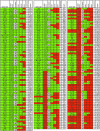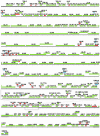Reevaluation of human cytomegalovirus coding potential
- PMID: 14593199
- PMCID: PMC263857
- DOI: 10.1073/pnas.1735466100
Reevaluation of human cytomegalovirus coding potential
Abstract
The Bio-Dictionary-based Gene Finder was used to reassess the coding potential of the AD169 laboratory strain of human cytomegalovirus and sequences in the Toledo strain that are missing in the laboratory strain of the virus. The gene-finder algorithm assesses the potential of an ORF to encode a protein based on matches to a database of amino acid patterns derived from a large collection of proteins. The algorithm was used to score all human cytomegalovirus ORFs with the potential to encode polypeptides >/=50 aa in length. As a further test for functionality, the genomes of the chimpanzee, rhesus, and murine cytomegaloviruses were searched for orthologues of the predicted human cytomegalovirus ORFs. The analysis indicates that 37 previously annotated ORFs ought to be discarded, and at least nine previously unrecognized ORFs with relatively strong coding potential should be added. Thus, the human cytomegalovirus genome appears to contain approximately 192 unique ORFs with the potential to encode a protein. Support for several of the predictions of our in silico analysis was obtained by sequencing several domains within a clinical isolate of human cytomegalovirus.
Figures


Similar articles
-
Coding potential of laboratory and clinical strains of human cytomegalovirus.Proc Natl Acad Sci U S A. 2003 Dec 9;100(25):14976-81. doi: 10.1073/pnas.2136652100. Epub 2003 Dec 1. Proc Natl Acad Sci U S A. 2003. PMID: 14657367 Free PMC article.
-
In silico pattern-based analysis of the human cytomegalovirus genome.J Virol. 2003 Apr;77(7):4326-44. doi: 10.1128/jvi.77.7.4326-4344.2003. J Virol. 2003. PMID: 12634390 Free PMC article.
-
Mapping and transcriptional analysis of the murine cytomegalovirus homologue of the human cytomegalovirus UL103 open reading frame.Virology. 1994 Nov 1;204(2):835-9. doi: 10.1006/viro.1994.1603. Virology. 1994. PMID: 7941355
-
Human cytomegalovirus genome.Curr Top Microbiol Immunol. 2008;325:1-19. doi: 10.1007/978-3-540-77349-8_1. Curr Top Microbiol Immunol. 2008. PMID: 18637497 Review.
-
Virus-encoded homologs of cellular interleukin-10 and their control of host immune function.J Virol. 2009 Oct;83(19):9618-29. doi: 10.1128/JVI.01098-09. Epub 2009 Jul 29. J Virol. 2009. PMID: 19640997 Free PMC article. Review. No abstract available.
Cited by
-
Immunogenic particles with a broad antigenic spectrum stimulate cytolytic T cells and offer increased protection against EBV infection ex vivo and in mice.PLoS Pathog. 2018 Dec 6;14(12):e1007464. doi: 10.1371/journal.ppat.1007464. eCollection 2018 Dec. PLoS Pathog. 2018. PMID: 30521644 Free PMC article.
-
Human cytomegalovirus genomics and transcriptomics through the lens of next-generation sequencing: revision and future challenges.Virus Genes. 2019 Apr;55(2):138-164. doi: 10.1007/s11262-018-1627-3. Epub 2019 Jan 2. Virus Genes. 2019. PMID: 30604286 Free PMC article. Review.
-
The human cytomegalovirus gene UL79 is required for the accumulation of late viral transcripts.J Virol. 2011 May;85(10):4841-52. doi: 10.1128/JVI.02344-10. Epub 2011 Mar 2. J Virol. 2011. PMID: 21367901 Free PMC article.
-
Rhesus CMV: an emerging animal model for human CMV.Med Microbiol Immunol. 2008 Jun;197(2):109-15. doi: 10.1007/s00430-007-0073-y. Epub 2008 Jan 11. Med Microbiol Immunol. 2008. PMID: 18193454 Free PMC article. Review.
-
Analysis of the human cytomegalovirus genomic region from UL146 through UL147A reveals sequence hypervariability, genotypic stability, and overlapping transcripts.Virol J. 2006 Jan 12;3:4. doi: 10.1186/1743-422X-3-4. Virol J. 2006. PMID: 16409621 Free PMC article.
References
-
- Britt, W. J. & Alford, C. A. (1996) in Fields Virology, eds. Fields, B. N., Knipe, D. M. & Howley, P. M. (Lippincott-Raven, Philadelphia), Vol. 2, pp. 2493-2524.
-
- Bankier, A. T., Beck, S., Bohni, R., Brown, C. M., Cerny, R., Chee, M. S., Hutchison, C. A., III, Kouzarides, T., Martignetti, J. A., Preddie, E., et al. (1991) DNA Sequences 2, 1-12. - PubMed
-
- Chee, M. S., Bankier, S., Beck, S., Bohni, R., Brown, C. R., Horsnell, T., Hutchisno, C. A., III, Kouzarides, T., Martignetti, J. A., Preddie, E., et al. (1990) Curr. Top. Microbiol. Immunol. 154, 125-169. - PubMed
-
- Baer, R., Bankier, A. T., Biggin, M. D., Deininger, P. L., Farrell, P. J., Gibson, T. J., Hatfull, G., Hudson, G. S., Satchwell, S. C., Seguin, C., et al. (1984) Nature 310, 207-211. - PubMed
-
- McGeoch, D. J., Dalrymple, M. A., Davison, A. J., Dolan, A., Frame, M. C., McNab, D., Perry, L. J., Scott, J. E. & Taylor, P. (1988) J. Gen. Virol. 69, 1531-1574. - PubMed
Publication types
MeSH terms
Substances
Associated data
- Actions
- Actions
- Actions
- Actions
- Actions
Grants and funding
LinkOut - more resources
Full Text Sources
Other Literature Sources
Research Materials

